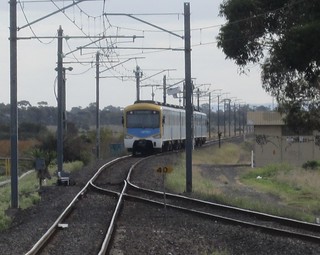 The Public Transport Users Association (PTUA) has called for duplication of critical single track bottlenecks on the Metro network, to help improve on-time running and boost train frequencies.
The Public Transport Users Association (PTUA) has called for duplication of critical single track bottlenecks on the Metro network, to help improve on-time running and boost train frequencies.
PTUA President Daniel Bowen said that that single line sections of track played havoc with punctuality, and severely limited the number of trains that could run.
“It is ludicrous that in the 21st century, we still have sections of single track on the Metro network. With increasing passenger numbers, it is now urgent that rail bottlenecks be duplicated.
“The rail network is the best, most efficient way of moving large numbers of people in our growing city, yet it is hamstrung by single track sections that hark back to the 19th century.
“These pinch points prevent the kind of reliable and frequent service a big city like Melbourne demands. For instance the single track Altona Loop has the least frequent peak-hour services anywhere in Zone 1, with a train only every 22 minutes.
“Single tracks mean any little delay quickly snowballs to affect trains in both directions, which in peak hour can easily mean thousands of people have their travel disrupted.”
Mr Bowen said that the last remaining single sections of the Epping/South Morang line had recently been duplicated, and that passengers are now seeing the benefits. The April 2012 timetable includes trains up to every 8 minutes in peak, helping to cut crowding. Mr Bowen said it was now time to duplicate the rest of the suburban network, starting with critical bottlenecks.
The PTUA believes the following sections of track should be prioritised for duplication to allow more frequent and punctual train services:
– Cranbourne line, Dandenong to Cranbourne – allowing more services to the growing south-east, and improving punctuality across the whole Pakenham/Cranbourne line
– Werribee line (Altona Loop) – cutting delays and allowing more frequent trains on this part of the line, which runs only every 22 minutes in peak hour
– Hurstbridge line, Heidelberg to Rosanna, allowing frequent services all day at least as far as Greensborough
– Upfield line, Gowrie to Upfield – allowing more frequent trains on the line, which runs only every 20 minutes in peak hour
– Melton line (V/Line), Deer Park (West) to Melton – allowing more frequent V/Line (and in the longer term, electrified Metro) services to Melbourne’s fast-growing outer-west
– Lilydale line, new Cave Hill station including passing loop, to provide a station for the local community, and as a first step to later full duplication of the line
“When traffic shares a single lane for both directions during road works, it causes long delays. This is what passengers put up with every day on suburban single track railway lines; it’s time these were fixed.
“Single track might be fine for Puffing Billy, but it has no place on a modern mass transit system”, concluded Mr Bowen.
* * *
Peak-hour frequencies on lines with single-track sections:
- Cranbourne line: gaps up to 18 minutes (AM peak) and 20 minutes (PM peak)
- Hurstbridge line: gaps up to 37 minutes (AM peak) and 41 minutes (PM peak) at some stations
- Altona Loop section of the Werribee line: 22 minutes
- Upfield line 20 minutes
- Melton line (V/Line): gaps up to 37 minutes (AM peak) and 35 minutes (PM peak) at some stations
- Lilydale line: gaps up to 19 minutes (AM peak)
(This is not an exhaustive list.)
Source: Metro timetables, April 2012

